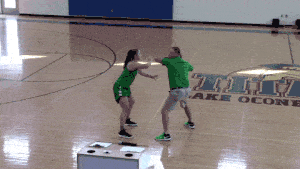Contents > 3. Offense > 3.1. 1/4-Court vs. Player-to-Player Defense > 3.1.1. 1v1 > 3.1.1.1. Before the Dribble >
3.1.1.1.2. Rip-Throughs & Step-Throughs
(1) Q: What are rip-throughs?
A: Rip-throughs utilize your arms and hands to move the ball into various positions around you, usually “ripping the ball through” vulnerable areas (areas where the defender can more easily steal the ball) into positions of strength and action (in this case, shot or dribble).
(2) Q: Which areas are vulnerable when being defended on-ball before the dribble?
A: The image below shows the vulnerable areas (red boxes), when you are facing up against the defender. The vulnerable areas are generally in the middle of your body, when the ball is exposed to the defender (the defender can swipe down or up and make contact with the ball). We can break the vulnerable areas into high, middle, and low:
(3) Q: Where are the areas of strength?
A: The areas of strength are generally in the shoulder and hip areas, where the ball is away from the defender, and the positioning of the arms adds strength. These areas are shown below:
(4) Q: How do we use rip-throughs in each vulnerable area?
A:
Middle: Move the ball quickly across the shoulders or hips, and diagonally through the middle of the body:
High: Move the ball quickly over (or even behind) your head from shoulder to shoulder
Low: Move the ball quickly below the knees from hip to hip; also called “sweeping the floor”
Combined: combining all the areas of rip-throughs are shown below:
(5) Q: What are step-throughs?
A: Step-throughs utilize your feet and legs to create space around you. Usually it involves your pivot foot remaining on the ground, and your non-pivot foot “stepping through” the space in the direction of the defender so that they are forced to move backwards. During the step-through, your body/hips will generally rotate in the clockwise or counterclockwise direction around your pivot foot. This creation of space allows for:
greater protection of the ball (forcing the defender to be farther from you)
an uncontested shot if needed
easier dribbling initiation
(in this step-through, the pivot foot remains on the ground, and the non-pivot foot steps through the space towards the defender)
(6) Q: How do we use rip-throughs when we step-through?
A: If you have already stepped-through, one side of your body will now be much closer to the defender. The areas of weakness will now be on the side closest to the defender, and areas of strength on the side of your body opposite of the defender. Your rip-throughs will continue going towards the areas of strength.
(this step-through also has a high rip-through; the ball ends up on the left shoulder, away from the defender)
Skills Drills
Skills Drill #1: Stationary Rip-Throughs
Each player has a ball standing around the three-point line. Starting from the triple-threat position, each player will work on each rip-through type for 10 seconds: middle, high, low, and combined. Ensure the ball remains in the areas of strength, and is ripped through quickly the areas of weakness.
Skills Drill #2: Rip-Throughs + Step-Throughs (Alone)
Similar to Skills Drill #1, however now each player will add step-throughs to their combined rip-throughs. Use both pivot feet for 10 seconds each, utilizing both clockwise/counter-clockwise directions.
Skills Drill #3: Rip-Throughs + Step-Throughs (with Defense)
Similar to Skills Drill #2, however now there will be a defender on the ball-handler. The defender will play defense for 10 seconds in each phase: low intensity defense (50%), medium intensity defense (75%), high intensity defense (100%, with some light intentional fouling).












